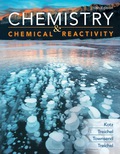
Chemistry & Chemical Reactivity
10th Edition
ISBN: 9781337670418
Author: Kotz
Publisher: Cengage
expand_more
expand_more
format_list_bulleted
Concept explainers
Question
Chapter 25, Problem 9PS
Interpretation Introduction
Interpretation:
Number of alpha and beta emission that occurs in the uranium-238 radioactive decay series ending with lead-206 has to be identified.
Concept introduction:
In alpha decay, there will be lose of
In beta decay, there will be a lose of electron from nucleus (neutron turns into proton): there will be no change in mass number and atomic number increases by one.
Expert Solution & Answer
Want to see the full answer?
Check out a sample textbook solution
Students have asked these similar questions
A partir de Aluminio y Co(NO3)2ꞏ6H2O, indicar las reacciones a realizar para obtener Azul de Thenard (Al2CoO4).
To obtain Thenard Blue (Al2CoO4), the following reaction is correct (performed in an oven):Al(OH)3 + Co(OH)2 → Al2CoO4 + 4 H2O
Problem 38 can u explain and solve thanks april 24
Chapter 25 Solutions
Chemistry & Chemical Reactivity
Ch. 25.2 - Prob. 25.1CYUCh. 25.2 - Prob. 25.2CYUCh. 25.3 - Prob. 25.3CYUCh. 25.3 - Prob. 25.4CYUCh. 25.4 - Prob. 25.5CYUCh. 25.4 - Prob. 25.6CYUCh. 25.4 - Prob. 25.7CYUCh. 25.5 - Prob. 25.8CYUCh. 25.8 - Prob. 25.9CYUCh. 25.8 - Prob. 1.1ACP
Ch. 25.8 - Prob. 1.2ACPCh. 25.8 - Prob. 1.3ACPCh. 25.8 - Calculate the molar mass (atomic weight) of...Ch. 25.8 - Prob. 2.1ACPCh. 25.8 - Prob. 2.2ACPCh. 25.8 - Prob. 2.3ACPCh. 25.8 - Prob. 2.4ACPCh. 25.8 - Prob. 2.5ACPCh. 25.8 - Prob. 2.6ACPCh. 25.8 - Prob. 3.1ACPCh. 25.8 - Prob. 3.2ACPCh. 25.8 - Prob. 3.3ACPCh. 25.8 - Prob. 3.4ACPCh. 25 - Prob. 1PSCh. 25 - Prob. 2PSCh. 25 - Prob. 4PSCh. 25 - Prob. 5PSCh. 25 - Prob. 6PSCh. 25 - Prob. 7PSCh. 25 - Prob. 8PSCh. 25 - Prob. 9PSCh. 25 - Prob. 10PSCh. 25 - Prob. 11PSCh. 25 - Prob. 12PSCh. 25 - Prob. 13PSCh. 25 - Prob. 14PSCh. 25 - Prob. 15PSCh. 25 - Prob. 16PSCh. 25 - Prob. 17PSCh. 25 - Prob. 18PSCh. 25 - Prob. 19PSCh. 25 - Prob. 20PSCh. 25 - Prob. 21PSCh. 25 - Prob. 22PSCh. 25 - Prob. 23PSCh. 25 - Prob. 24PSCh. 25 - Prob. 25PSCh. 25 - Prob. 26PSCh. 25 - Prob. 27PSCh. 25 - Prob. 28PSCh. 25 - Prob. 29PSCh. 25 - Prob. 30PSCh. 25 - Prob. 31PSCh. 25 - Prob. 32PSCh. 25 - Prob. 33PSCh. 25 - Prob. 34PSCh. 25 - Prob. 35PSCh. 25 - Prob. 36PSCh. 25 - Prob. 37PSCh. 25 - Prob. 38PSCh. 25 - Prob. 39PSCh. 25 - Prob. 40PSCh. 25 - Prob. 41PSCh. 25 - Prob. 42PSCh. 25 - Prob. 43PSCh. 25 - Prob. 44PSCh. 25 - Prob. 45PSCh. 25 - Prob. 46PSCh. 25 - Prob. 47PSCh. 25 - Prob. 48PSCh. 25 - Prob. 49PSCh. 25 - Prob. 50PSCh. 25 - Prob. 51PSCh. 25 - Prob. 52PSCh. 25 - Prob. 53PSCh. 25 - Prob. 54PSCh. 25 - Prob. 55PSCh. 25 - Some of the reactions explored by Ernest...Ch. 25 - Prob. 57GQCh. 25 - Prob. 58GQCh. 25 - Prob. 59GQCh. 25 - Prob. 60GQCh. 25 - Prob. 61GQCh. 25 - Prob. 62GQCh. 25 - Prob. 63GQCh. 25 - Prob. 64GQCh. 25 - Prob. 65ILCh. 25 - Prob. 66ILCh. 25 - Prob. 67ILCh. 25 - Prob. 68ILCh. 25 - Prob. 69ILCh. 25 - Prob. 70ILCh. 25 - Prob. 71SCQCh. 25 - Prob. 72SCQCh. 25 - Prob. 73SCQCh. 25 - Prob. 74SCQCh. 25 - Prob. 76SCQCh. 25 - Prob. 77SCQCh. 25 - Prob. 78SCQCh. 25 - Prob. 79SCQ
Knowledge Booster
Learn more about
Need a deep-dive on the concept behind this application? Look no further. Learn more about this topic, chemistry and related others by exploring similar questions and additional content below.Similar questions
arrow_back_ios
SEE MORE QUESTIONS
arrow_forward_ios
Recommended textbooks for you
 Chemistry: The Molecular ScienceChemistryISBN:9781285199047Author:John W. Moore, Conrad L. StanitskiPublisher:Cengage Learning
Chemistry: The Molecular ScienceChemistryISBN:9781285199047Author:John W. Moore, Conrad L. StanitskiPublisher:Cengage Learning Chemistry & Chemical ReactivityChemistryISBN:9781337399074Author:John C. Kotz, Paul M. Treichel, John Townsend, David TreichelPublisher:Cengage Learning
Chemistry & Chemical ReactivityChemistryISBN:9781337399074Author:John C. Kotz, Paul M. Treichel, John Townsend, David TreichelPublisher:Cengage Learning General, Organic, and Biological ChemistryChemistryISBN:9781285853918Author:H. Stephen StokerPublisher:Cengage Learning
General, Organic, and Biological ChemistryChemistryISBN:9781285853918Author:H. Stephen StokerPublisher:Cengage Learning- Chemistry: Matter and ChangeChemistryISBN:9780078746376Author:Dinah Zike, Laurel Dingrando, Nicholas Hainen, Cheryl WistromPublisher:Glencoe/McGraw-Hill School Pub Co
 Chemistry for Engineering StudentsChemistryISBN:9781337398909Author:Lawrence S. Brown, Tom HolmePublisher:Cengage Learning
Chemistry for Engineering StudentsChemistryISBN:9781337398909Author:Lawrence S. Brown, Tom HolmePublisher:Cengage Learning Principles of Modern ChemistryChemistryISBN:9781305079113Author:David W. Oxtoby, H. Pat Gillis, Laurie J. ButlerPublisher:Cengage Learning
Principles of Modern ChemistryChemistryISBN:9781305079113Author:David W. Oxtoby, H. Pat Gillis, Laurie J. ButlerPublisher:Cengage Learning

Chemistry: The Molecular Science
Chemistry
ISBN:9781285199047
Author:John W. Moore, Conrad L. Stanitski
Publisher:Cengage Learning

Chemistry & Chemical Reactivity
Chemistry
ISBN:9781337399074
Author:John C. Kotz, Paul M. Treichel, John Townsend, David Treichel
Publisher:Cengage Learning

General, Organic, and Biological Chemistry
Chemistry
ISBN:9781285853918
Author:H. Stephen Stoker
Publisher:Cengage Learning

Chemistry: Matter and Change
Chemistry
ISBN:9780078746376
Author:Dinah Zike, Laurel Dingrando, Nicholas Hainen, Cheryl Wistrom
Publisher:Glencoe/McGraw-Hill School Pub Co

Chemistry for Engineering Students
Chemistry
ISBN:9781337398909
Author:Lawrence S. Brown, Tom Holme
Publisher:Cengage Learning

Principles of Modern Chemistry
Chemistry
ISBN:9781305079113
Author:David W. Oxtoby, H. Pat Gillis, Laurie J. Butler
Publisher:Cengage Learning